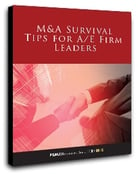 The A/E space is a highly fragmented industry and, as a result, it is composed of a great number of small firms with fewer than ten or fifteen employees. Many of these firms grew from a one-person operation to the profitable and successful operations that they are today. However, at PSMJ, we hear frequently from leaders of these small firms that they are at a crossroads.
The A/E space is a highly fragmented industry and, as a result, it is composed of a great number of small firms with fewer than ten or fifteen employees. Many of these firms grew from a one-person operation to the profitable and successful operations that they are today. However, at PSMJ, we hear frequently from leaders of these small firms that they are at a crossroads.
Most frequently, these leaders are facing one or more of the following challenges to continued growth and prosperity of the business:
-
A changing competitive landscape.
-
An internal succession bottleneck.
-
Bigger professional development objectives.
While many of these businesses have been quite successful operating independently, they have reached a point where succession of the business will come through an external sale. With this as a backdrop, there are some key pitfalls to avoid when considering or embarking on the process of selling a small A/E firm. Here are five of them:
-
Serious reservations and conflict as to whether external sale is the right course of action. Of course, there will always be some reservation and reluctance in this. But, candid and transparent discussion among the ownership/leadership team is a must. In the end, not all will agree with the strategy but they must agree that it is the selected strategy. Don’t get into serious discussions with prospective buyers until there have been some serious discussions inside the firm.
-
Viewing internal succession and an external sale as mutually exclusive. To some extent they are mutually exclusive. That is, in a small firm, you cannot be executing both at the same time. However, building a team and creating value with the long-term expectation of aligning with a like-minded strategic partner for continued personal and corporate growth is a very viable strategy.
-
Unrealistic valuation expectations. Again, there is always some degree of reluctance in this and that is often, in first generation firms, driven by a level of sentimental value. Buyers don’t buy sentimental value. Further, buyers will seek institutional value as opposed a firm’s fortunes that are tied largely to one or two rainmakers. Get an outside opinion on the value and marketability of the firm before going to the negotiating table.
-
Unclear picture of what post-acquisition life will be. It won’t be cash at closing and riding off into the sunset. Especially if there is a lot of firm value tied up in key individual(s), expect to stick around for a while. And, more than just stick around, expect to be working quite hard. Make sure that you are completely comfortable with your post-acquisition role (and reporting relationships) and ask plenty of questions about this in the early courtship stages.
-
Not keeping the firm transaction-ready. Let’s say that you aren’t actively marketing the firm but are passively open to considering opportunities. Most buyers will cut you some slack and be somewhat patient while you gather requested information. However, this only goes so far. Financial statements that must be created from scratch or that are loaded with personal expenses can be a big turn-off. Additionally, a well-conceived and up-todate strategic business plan can go a long way towards showing a prospective buyer that remaining independent is a very viable option.
From our 40+ years of advising A/E firm leaders on growth and succession planning, we can certainly provide a long list of where firms can go and have gone wrong in the process. But, for starters, consider these five points and how your firm stacks up. If an external sale may be on the horizon for your small firm, take action today to steer clear of where others have landed in a ditch!
About the Author: As a consultant with PSMJ, Greg Hart advises clients primarily in the areas of mergers & acquisitions, ownership succession planning, and business valuation. He has personally worked with dozens of architecture, engineering, and environmental consulting firms on these matters. Outside of his consulting work, Greg leads PSMJ’s overall marketing efforts across all of our business units.
 No matter where you perceive your readiness, a first step to your future success is in understanding the process, and possible pitfalls along the way. It is easy for the uninformed to make one small oversight or misjudgment that leads to major problems later on. In this complimentary ebook, M&A Survival Tips for A/E Firm Leaders, we aim to help you navigate through some of the thornier parts of getting started as well as implementing a realistic and successful M&A plan.
No matter where you perceive your readiness, a first step to your future success is in understanding the process, and possible pitfalls along the way. It is easy for the uninformed to make one small oversight or misjudgment that leads to major problems later on. In this complimentary ebook, M&A Survival Tips for A/E Firm Leaders, we aim to help you navigate through some of the thornier parts of getting started as well as implementing a realistic and successful M&A plan.
Other M&A Related Posts
Getting Ready to Sell? Think Like a Buyer!
Expert Interview: Assessing Current M&A Market Conditons and Trends



